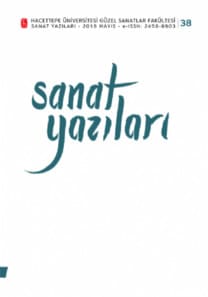KAMERA KÜLTÜRÜNÜN YÜKSELİŞİ VE KİMLİK OYUNLARI
THE RISE OF CAMERA CULTURE AND IDENTITY GAMES
___
Barthes, Roland. (1996). Camera Lucida (R. Akçakaya, Çev.). İstanbul: Altıkırkbeş Yayınları.Barthes, Roland. (1977). Image Music Text (S. Heart, Çev.). London: Fontana Press.
Baudelaire, Charles. (2002 ). Fotografi Sanat mı?. Enis Batur (Ed.). Modernizmin Serüveni, s. 25-27. İstanbul: Yapı Kredi Yayınları.
Butler, Judith. (2014). Cinsiyet Belası-Feminizm ve Kimliğin Altüst Edilmesi (B. Ertür, Çev.). İstanbul: Metis Yayınları.
Davidoff, Leonore. (1979). Class and Gender in Victorian England: The Diaries of Arthur J. Munby and Hannah Cullwick. Feminist Studies, 5, s. 86-141.
Dawkins, Heather. (1987). The Diaries And Photographs Of Hannah Cullwick. Art History, 10, s. 154-187.
Doane, Marry Ann. (1982). Film and the Masquerade Theorising the Female Spectator. Screen, 23, s. 74-88.
Eldem, Edhem. (2015). Görüntülerin Gücü-Fotoğrafın Osmanlı İmparatorluğu’nda Yayılması ve Etkisi, 1870-1914. Zeynep Çelik, Edhem Eldem. (Ed.). Camera Ottomana: Osmanlı İmparatorluğu’nda Fotoğraf ve Modernite 1840-1914, s. 106-153. İstanbul: Koç Üniversitesi Yayınları.
Fatma Aliye. (2012). Üçüncü Muhavere. Hülya Argunşah (Haz.). Nisvan-ı İslam, s. 105-146. İstanbul: Kesit Yayınları.
Foucault, Michel. (2003). Cinselliğin Tarihi (H.U. Tanrıöver, Çev.). İstanbul: Ayrıntı Yayınları.
Garber, Marjorie. (1992). Vested Interests: Cross-Dressing and Cultural Anxiety. New York: Routledge.
Gisele, Freund. (2006). Fotoğraf ve Toplum (Ş. Demirkol, Çev.). İstanbul: Sel Yayınları.
Jones, Amelia. (1997). Tracing the Subject with Cindy Sherman. Amada Cruz, Elizabeth Smith, Amelia Jones (Haz.), Cindy Sherman Retrospective, s. 33-53. New York: Thames and Hudson.
Jones, Amelia. (2002). The Eternal Return: Self-Portrait Photography as a Technology of Embodiment, Signs:Journal of Women in Culture and Society. 27, s. 947-978.
Jones, Amelia. (1998). Body Art Performing the Subject. Minnesota: University of Minnesota Press.
Kernan, Nathan. (2000). A Game of Madness: The Photographs of the Contessa di Castiglione. Art on Paper. 5, s. 48-52.
Micklewright, Nancy. (2010). Harem/House/Set: Domestic Interiors in Photography from the Late Ottoman World. Marilyn Booth (Ed.). Harem Histories. Envisioning Places and Living Spaces, s. 239-260. London: Duke University Press.
Owens, Craig. (1992). Beyond Recognition: Representation, Power, and Culture. London: University of California Press.
Plunkett, John. (2003). Celebrity and Community: The Poetics of the Carte-de-visite. Journal of Victorian Culture, 8, s. 55-79.
Phelan, Peggy. (2003). Unmarked: The Politics of Performance. London: Routledge.
Riviere, Joan. (1929). Womanliness as Masquerade. International Journal of Psychoanalysis, 10, s. 303-313.
Roberts, Marry. (2007). Intimate Outsiders: The Harem in Ottoman and Orientalist Art and Travel Literature. Durham: Duke University Press.
Roberts, Marry. (2014). Nazlı’s Photographic Games: Said and Art History in a Contrapuntal Mode. Patterns of Prejudice, 48, s. 460–478.
Solomon-Godeau, Abigail. (1986). The Legs of the Countess. October, 39, s. 65-108.
- ISSN: 2458-8903
- Yayın Aralığı: Yılda 2 Sayı
- Başlangıç: 2001
- Yayıncı: -
JEAN BAUDRİLLARD’IN SİMÜLASYON KURAMI VE TANSEL TÜRKDOĞAN’IN SANAT UYGULAMALARI
SPEKÜLATİF KURGU FİLM JENERİKLERİ VE X-MEN FİLMLERİ ÜZERİNDEN BİR İNCELEME
İŞİTSEL PEYZAJ OLARAK GÜRÜLTÜ KAVRAMININ ÇAĞDAŞ SANATTAKİ ÜÇ TEMSİLİ
AFİŞLE İLGİLİ LİSANSÜSTÜ TEZLERİN BAZI TANIMLAYICI ÖZELLİKLERİNİN İNCELENMESİ
KAMERA KÜLTÜRÜNÜN YÜKSELİŞİ VE KİMLİK OYUNLARI
20. YÜZYILDAN GÜNÜMÜZE PLASTİK SANAT ESERİNDE ESTETİK BİR DEĞER OLARAK YAZININ VARLIĞI
ÇAĞIMIZ TEKNOLOJİK GELİŞMELERİNİN SAHNE VE GÖSTERİ SANATLARINDAKİ KOSTÜM TASARIMINA YANSIMALARI
BİHZÂD’IN MİNYATÜRLERİ: MİNYATÜR SANATINDA ZAMAN VE MEKÂNIN İNŞASINA DAİR İKİ ÖRNEK
GOULD’UN KONTRAPUNTAL YAKLAŞIMI: TEKNOLOJİ, MÜZİK, MİLLİYETÇİLİK
KÜLTÜREL MİRASIN KORUNMASINDA FOTOGRAMETRİ TEKNİĞİNİN KULLANILMASI: ANA TANRIÇA HEYKELİ ÖRNEĞİ
